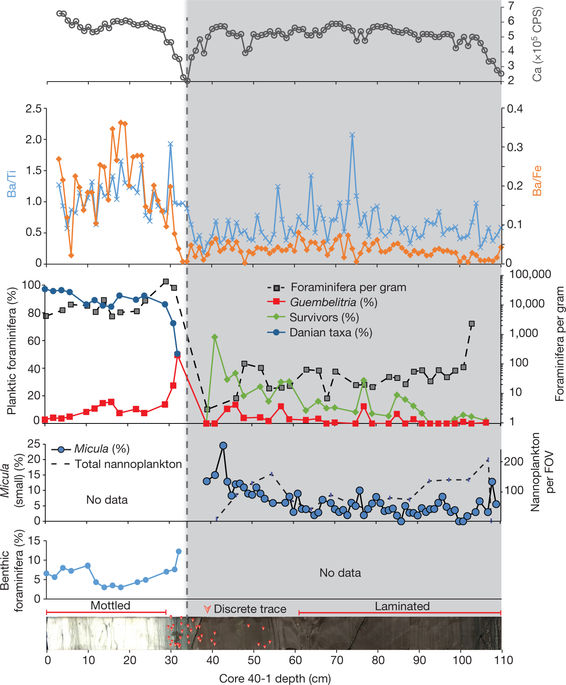Our official English website, www.x-mol.net, welcomes your
feedback! (Note: you will need to create a separate account there.)
Rapid recovery of life at ground zero of the end-Cretaceous mass extinction
Nature ( IF 50.5 ) Pub Date : 2018-05-30 , DOI: 10.1038/s41586-018-0163-6 Christopher M. Lowery , Timothy J. Bralower , Jeremy D. Owens , Francisco J. Rodríguez-Tovar , Heather Jones , Jan Smit , Michael T. Whalen , Phillipe Claeys , Kenneth Farley , Sean P. S. Gulick , Joanna V. Morgan , Sophie Green , Elise Chenot , Gail L. Christeson , Charles S. Cockell , Marco J. L. Coolen , Ludovic Ferrière , Catalina Gebhardt , Kazuhisa Goto , David A. Kring , Johanna Lofi , Rubén Ocampo-Torres , Ligia Perez-Cruz , Annemarie E. Pickersgill , Michael H. Poelchau , Auriol S. P. Rae , Cornelia Rasmussen , Mario Rebolledo-Vieyra , Ulrich Riller , Honami Sato , Sonia M. Tikoo , Naotaka Tomioka , Jaime Urrutia-Fucugauchi , Johan Vellekoop , Axel Wittmann , Long Xiao , Kosei E. Yamaguchi , William Zylberman
Nature ( IF 50.5 ) Pub Date : 2018-05-30 , DOI: 10.1038/s41586-018-0163-6 Christopher M. Lowery , Timothy J. Bralower , Jeremy D. Owens , Francisco J. Rodríguez-Tovar , Heather Jones , Jan Smit , Michael T. Whalen , Phillipe Claeys , Kenneth Farley , Sean P. S. Gulick , Joanna V. Morgan , Sophie Green , Elise Chenot , Gail L. Christeson , Charles S. Cockell , Marco J. L. Coolen , Ludovic Ferrière , Catalina Gebhardt , Kazuhisa Goto , David A. Kring , Johanna Lofi , Rubén Ocampo-Torres , Ligia Perez-Cruz , Annemarie E. Pickersgill , Michael H. Poelchau , Auriol S. P. Rae , Cornelia Rasmussen , Mario Rebolledo-Vieyra , Ulrich Riller , Honami Sato , Sonia M. Tikoo , Naotaka Tomioka , Jaime Urrutia-Fucugauchi , Johan Vellekoop , Axel Wittmann , Long Xiao , Kosei E. Yamaguchi , William Zylberman

|
The Cretaceous/Palaeogene mass extinction eradicated 76% of species on Earth1,2. It was caused by the impact of an asteroid3,4 on the Yucatán carbonate platform in the southern Gulf of Mexico 66 million years ago5, forming the Chicxulub impact crater6,7. After the mass extinction, the recovery of the global marine ecosystem—measured as primary productivity—was geographically heterogeneous8; export production in the Gulf of Mexico and North Atlantic–western Tethys was slower than in most other regions8–11, taking 300 thousand years (kyr) to return to levels similar to those of the Late Cretaceous period. Delayed recovery of marine productivity closer to the crater implies an impact-related environmental control, such as toxic metal poisoning12, on recovery times. If no such geographic pattern exists, the best explanation for the observed heterogeneity is a combination of ecological factors—trophic interactions13, species incumbency and competitive exclusion by opportunists14—and ‘chance’8,15,16. The question of whether the post-impact recovery of marine productivity was delayed closer to the crater has a bearing on the predictability of future patterns of recovery in anthropogenically perturbed ecosystems. If there is a relationship between the distance from the impact and the recovery of marine productivity, we would expect recovery rates to be slowest in the crater itself. Here we present a record of foraminifera, calcareous nannoplankton, trace fossils and elemental abundance data from within the Chicxulub crater, dated to approximately the first 200 kyr of the Palaeocene. We show that life reappeared in the basin just years after the impact and a high-productivity ecosystem was established within 30 kyr, which indicates that proximity to the impact did not delay recovery and that there was therefore no impact-related environmental control on recovery. Ecological processes probably controlled the recovery of productivity after the Cretaceous/Palaeogene mass extinction and are therefore likely to be important for the response of the ocean ecosystem to other rapid extinction events.Micro- and nannofossil, trace fossil and geochemical evidence from the Chicxulub impact crater demonstrates that proximity to the asteroid impact site did not determine rates of recovery of marine ecosystems after the end-Cretaceous mass extinction.
中文翻译:

白垩纪末大灭绝零地生命的快速恢复
白垩纪/古近纪大灭绝灭绝了地球上 76% 的物种1,2。它是由 6600 万年前一颗小行星 3,4 撞击墨西哥湾南部尤卡坦碳酸盐平台 5 造成的,形成了希克苏鲁伯撞击坑 6,7。大灭绝之后,全球海洋生态系统的恢复——以初级生产力衡量——在地理上是异质的8;墨西哥湾和北大西洋-西特提斯群岛的出口产量低于大多数其他地区 8-11,需要 30 万年 (kyr) 才能恢复到与晚白垩世相似的水平。靠近火山口的海洋生产力的延迟恢复意味着恢复时间与影响相关的环境控制,例如有毒金属中毒12。如果不存在这样的地理模式,观察到的异质性的最佳解释是生态因素的组合——营养相互作用 13、物种在位和机会主义者的竞争排斥 14——和“机会”8、15、16。海洋生产力的影响后恢复是否在靠近火山口的地方延迟的问题与人为扰动的生态系统中未来恢复模式的可预测性有关。如果撞击的距离与海洋生产力的恢复之间存在关系,我们预计火山口本身的恢复速度最慢。在这里,我们展示了希克苏鲁伯陨石坑内的有孔虫、钙质微浮游生物、微量化石和元素丰度数据的记录,大约可追溯到古新世的前 200 kyr。我们表明生命在撞击后几年重新出现在盆地中,并且在 30 kyr 内建立了一个高生产力的生态系统,这表明靠近撞击并没有延迟恢复,因此没有与撞击相关的恢复环境控制。生态过程可能控制了白垩纪/古近纪大灭绝后生产力的恢复,因此可能对海洋生态系统对其他快速灭绝事件的响应很重要。来自希克苏鲁伯撞击坑的微化石和微化石、微量化石和地球化学证据表明靠近小行星撞击地点并不能决定白垩纪末大灭绝后海洋生态系统的恢复速度。这表明靠近影响并没有延迟恢复,因此没有与影响相关的恢复环境控制。生态过程可能控制了白垩纪/古近纪大灭绝后生产力的恢复,因此可能对海洋生态系统对其他快速灭绝事件的响应很重要。来自希克苏鲁伯撞击坑的微化石和微化石、微量化石和地球化学证据表明靠近小行星撞击地点并不能决定白垩纪末大灭绝后海洋生态系统的恢复速度。这表明靠近影响并没有延迟恢复,因此没有与影响相关的恢复环境控制。生态过程可能控制了白垩纪/古近纪大灭绝后生产力的恢复,因此可能对海洋生态系统对其他快速灭绝事件的响应很重要。来自希克苏鲁伯撞击坑的微化石和微化石、微量化石和地球化学证据表明靠近小行星撞击地点并不能决定白垩纪末大灭绝后海洋生态系统的恢复速度。
更新日期:2018-05-30
中文翻译:

白垩纪末大灭绝零地生命的快速恢复
白垩纪/古近纪大灭绝灭绝了地球上 76% 的物种1,2。它是由 6600 万年前一颗小行星 3,4 撞击墨西哥湾南部尤卡坦碳酸盐平台 5 造成的,形成了希克苏鲁伯撞击坑 6,7。大灭绝之后,全球海洋生态系统的恢复——以初级生产力衡量——在地理上是异质的8;墨西哥湾和北大西洋-西特提斯群岛的出口产量低于大多数其他地区 8-11,需要 30 万年 (kyr) 才能恢复到与晚白垩世相似的水平。靠近火山口的海洋生产力的延迟恢复意味着恢复时间与影响相关的环境控制,例如有毒金属中毒12。如果不存在这样的地理模式,观察到的异质性的最佳解释是生态因素的组合——营养相互作用 13、物种在位和机会主义者的竞争排斥 14——和“机会”8、15、16。海洋生产力的影响后恢复是否在靠近火山口的地方延迟的问题与人为扰动的生态系统中未来恢复模式的可预测性有关。如果撞击的距离与海洋生产力的恢复之间存在关系,我们预计火山口本身的恢复速度最慢。在这里,我们展示了希克苏鲁伯陨石坑内的有孔虫、钙质微浮游生物、微量化石和元素丰度数据的记录,大约可追溯到古新世的前 200 kyr。我们表明生命在撞击后几年重新出现在盆地中,并且在 30 kyr 内建立了一个高生产力的生态系统,这表明靠近撞击并没有延迟恢复,因此没有与撞击相关的恢复环境控制。生态过程可能控制了白垩纪/古近纪大灭绝后生产力的恢复,因此可能对海洋生态系统对其他快速灭绝事件的响应很重要。来自希克苏鲁伯撞击坑的微化石和微化石、微量化石和地球化学证据表明靠近小行星撞击地点并不能决定白垩纪末大灭绝后海洋生态系统的恢复速度。这表明靠近影响并没有延迟恢复,因此没有与影响相关的恢复环境控制。生态过程可能控制了白垩纪/古近纪大灭绝后生产力的恢复,因此可能对海洋生态系统对其他快速灭绝事件的响应很重要。来自希克苏鲁伯撞击坑的微化石和微化石、微量化石和地球化学证据表明靠近小行星撞击地点并不能决定白垩纪末大灭绝后海洋生态系统的恢复速度。这表明靠近影响并没有延迟恢复,因此没有与影响相关的恢复环境控制。生态过程可能控制了白垩纪/古近纪大灭绝后生产力的恢复,因此可能对海洋生态系统对其他快速灭绝事件的响应很重要。来自希克苏鲁伯撞击坑的微化石和微化石、微量化石和地球化学证据表明靠近小行星撞击地点并不能决定白垩纪末大灭绝后海洋生态系统的恢复速度。











































 京公网安备 11010802027423号
京公网安备 11010802027423号